Here’s How the 2022 Hyundai Ioniq 5 Compares with the Kia EV6
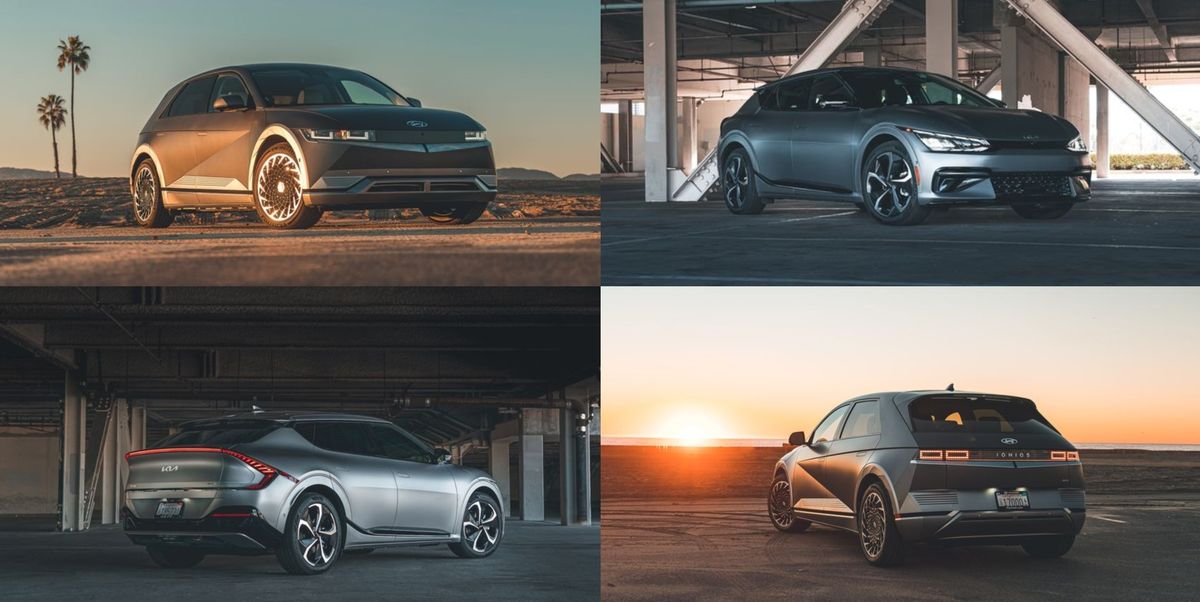
The Hyundai Ioniq 5 has a futuristically funky design that not only distinguishes it from other electric SUVs, but also almost everything else on the road. The Kia EV6 isn’t as extroverted, but its long and low proportions help create an unequivocally sleek aesthetic. Despite looking drastically different inside and out, the Hyundai and Kia have a lot in common, as they ride on the same platform and share major electrical components. They also have some minor distinctions. While we’re big fans of both, we’ve decided to compare the EV6 with the Ioniq 5 to see how these electrifying models stack up.
Powertrains and Performance
The EV6 and Ioniq 5 are available in both rear- and all-wheel-drive configurations. The base rear-drive models are rated at 167 and 168 horsepower, respectively, and 258 pound-feet of torque. There are also more powerful versions with 225 horses and the same amount of torque. The all-wheel-drive EV6 and Ioniq 5 have an electric motor on both axles that make a combined 320 horses and 446 pound-feet. A 576-hp EV6 GT model will also eventually join the lineup, and—as of now—there’s not an Ioniq 5 with equivalent performance in the pipeline.
Marc UrbanoCar and Driver
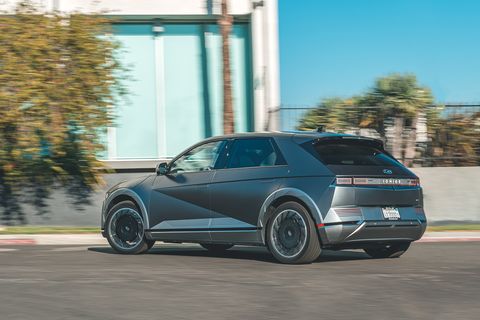
Marc UrbanoCar and Driver
We tested the dual-motor EV6 GT-Line and Ioniq 5 Limited, and they hit 60 mph in an identical 4.5 seconds. That’s only two-tenths slower than a 480-hp Ford Mustang Mach-E GT we tested. The Hyundai and Kia were also within a tenth or two of each other in our other acceleration tests, with the Ioniq 5 being slightly quicker to 100 mph (12.6 seconds) and through the quarter-mile (13.2 seconds at 102 mph). Our main takeaway? The Hyundai is quicker than it looks, but neither model will run away from the other in a drag race.
Battery, Charging, and Range
The EV6 and Ioniq 5 are available with standard- and long-range batteries. The former has a 58.0-kWh capacity, and the latter has a 77.4-kWh capacity. Both models have a 10.9-kW onboard charger. Hyundai and Kia estimate that with a 240-volt connection it’ll take just under six hours to charge the battery from 10 to 100 percent with the standard battery and just over seven for the bigger one. Hooked up to a 350-kW fast-charger, the EV6 and Ioniq 5 are estimated to charge both batteries from 10 to 80 percent in 18 minutes.
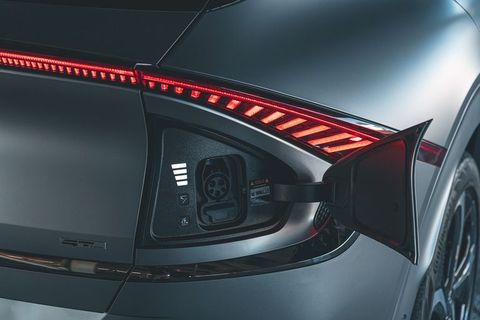
Marc UrbanoCar and Driver
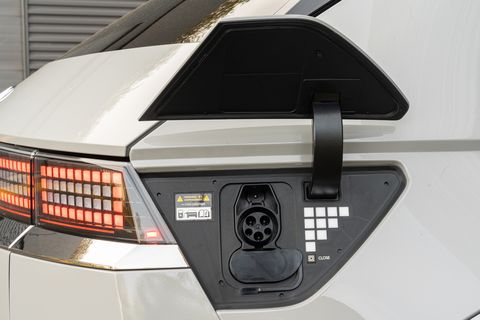
Hyundai
Despite sharing battery packs and other electrical components, the EV6 and Ioniq 5 don’t have identical EPA ratings. When it comes to range, the Kia has higher estimates. With the standard battery, the rear-drive EV6 is rated at 232 miles. With the long-range battery, the all-wheel-drive version is rated at 274 miles and the rear-drive version is rated at 310 miles. The rear-drive Ioniq 5 with the standard battery is rated at 220 miles, and that rating rises to 303 miles with the long-range pack. The all-wheel-drive version has a 256-mile rating (Hyundai claims that estimate will rise to 266 miles for 2023). We tested all-wheel-drive versions of both on our 75-mph highway route. The EV6 made it 230 miles on a single charge, whereas the Ioniq 5 went 210 miles, meaning they both missed their EPA ratings by almost the same margin.
Interior, Infotainment, and Cargo Space
It’s like two different worlds inside the EV6 and Ioniq 5. The Hyundai’s interior is airy and bright, with an emphasis on simple styling elements and comfortable passenger accommodations. The Ioniq’s coolest features include a movable center console that slides 5.5 inches fore and aft as well as an available footrest for the driver’s seat. The Kia’s cabin has more darker bits and feels more low-slung, with a floating center console that splits the front seats. While the EV6 doesn’t have as many unique features as the Ioniq 5, it has more straightforward switchgear and lots of cubby storage.
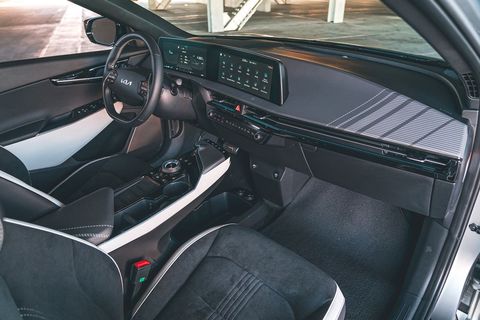
Marc UrbanoCar and Driver
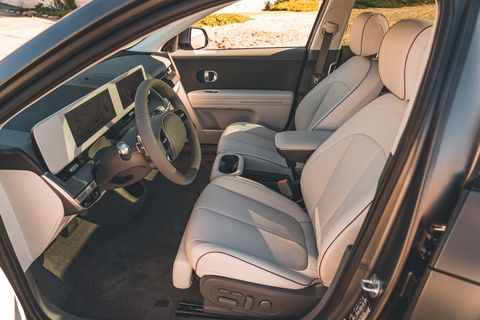
Marc UrbanoCar and Driver
When it comes to tech features, the Hyundai and Kia have the same equipment; it’s just presented in different ways. Both EVs have dual 12.3-inch displays on their dashboards that house the gauge cluster and infotainment touchscreen. Unlike the EV6, the Ioniq’s display panel has a small magnetic board to the left of the gauges that lets people post things like on a refridgerator. Both have standard Apple CarPlay and Android Auto, but wireless pairing currently isn’t available. A head-up display with an augmented-reality function is reserved for the top-of-the-line EV6 GT-Line and Ioniq 5 Limited. Unlike the Ioniq, the EV6 lineup offers upscale features at lower price points. The list includes driver’s-seat memory settings, wireless phone charging, ventilated front seats, and a premium audio system. Plus, only the Kia offers heated rear seats.

Marc UrbanoCar and Driver

Marc UrbanoCar and Driver
The EV6 has a long 114.2-inch wheelbase, and the Ioniq 5’s is almost four inches longer. Most of that extra space goes to front-seat passengers, who enjoy about two inches more legroom. The two EVs have similar rear-seat legroom, but the Ioniq does offer slightly more headroom and about two inches of extra shoulder room back there. The Hyundai has the advantage in cargo volume. Its 27 cubic feet behind the rear seat and 59 cubes with the rear seat folded are both three cubic feet more than in the Kia. When it comes to towing cargo, both models can handle up to 2300 pounds.
Price and Trim Levels
The Kia EV6 and Hyundai Ioniq 5 each have three trim levels and similar pricing. While the Ioniq’s lineup benefits from slightly lower starting prices, as we alluded to earlier, the middle of the EV6 lineup has better standard features. In the end, choosing between the two will likely come down to which one is considered more physically attractive. Other deciding factors could be the Kia’s longer estimated range or the Hyundai’s extra cargo and passenger space. Their MSRP probably won’t play a big part, but here’s a look at how their prices compare.
2022 Kia EV6
Marc UrbanoCar and Driver
Light: $42,695Wind: $48,795GT-Line: $52,995
The Light is the base-model EV6, and it’s only available with the 167-hp rear-drive configuration and standard-range battery. The Wind and GT-Line come standard with a 225-hp rear-drive setup and the long-range battery. Adding a second motor up front creates all-wheel drive and boosts horsepower to 320. It’s a $3900 option on the Wind and a $4700 option on the GT-Line. That brings their starting prices to $52,695 and $57,695, respectively.
2022 Hyundai Ioniq 5
Marc UrbanoCar and Driver
SE: $41,245 SEL: $47,545 Limited: $52,395
Unlike the EV6, the Ioniq 5’s base SE model is available with rear- or all-wheel drive and the standard- or long-range battery. The rear-drive version with just the bigger battery increases horsepower from 168 to 225 and costs $45,295; all-wheel drive provides 320 horses and pushes the price to $48,795. Both the SEL and Limited are only available with the long-range battery, but opting for the dual-motor configuation costs $3500 on the former and $3900 on the latter. That brings their starting prices to $51,045 and $56,295, respectively.
This content is imported from {embed-name}. You may be able to find the same content in another format, or you may be able to find more information, at their web site.

This content is created and maintained by a third party, and imported onto this page to help users provide their email addresses. You may be able to find more information about this and similar content at piano.io



